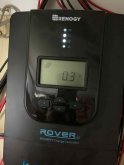Tam O'Bedlam
New Member
- Joined
- May 17, 2020
- Messages
- 3
About 2 years ago I bought from Amazon, 3 100w Renogy Panels, the ROVER 40A Controller and 2 AGM Batteries (155ah each). Installed them on/in my van and they have worked fine for the last almost two years.
Yesterday afternoon I was cleaning and noticed that the Controller claims it is nighttime, and my batteries have dropped down to 53% (which normally they never get lower than 67%) now it was a partly cloudy day, but it certainly isn't nighttime! The only thing the manual says in troubleshooting about this is to make sure you have the wires hooked up correctly, I know they are of course since everything has worked swimmingly for quite some time. I cannot reach Renogy support. I made sure the connections to the controller are tight, I even got the ladder out and checked the ones on the roof and made sure the panels were clean, everything seems fine. I restarted the controller as well, same thing.
Any suggestions?
Yesterday afternoon I was cleaning and noticed that the Controller claims it is nighttime, and my batteries have dropped down to 53% (which normally they never get lower than 67%) now it was a partly cloudy day, but it certainly isn't nighttime! The only thing the manual says in troubleshooting about this is to make sure you have the wires hooked up correctly, I know they are of course since everything has worked swimmingly for quite some time. I cannot reach Renogy support. I made sure the connections to the controller are tight, I even got the ladder out and checked the ones on the roof and made sure the panels were clean, everything seems fine. I restarted the controller as well, same thing.
Any suggestions?




